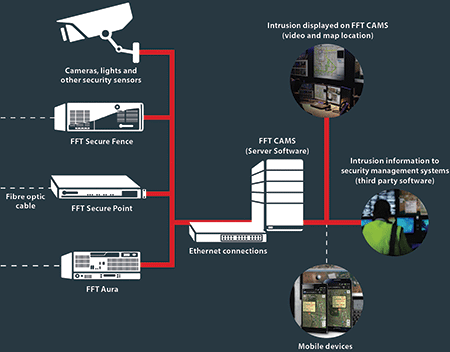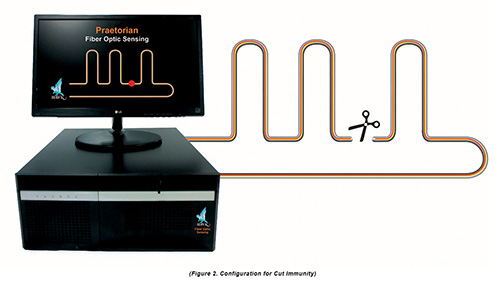Security Fibers: A Reliable Solution for Advanced Security Systems
Security Fibers: A Reliable Solution for Advanced Security Systems
Blog Article
The Ultimate Overview to Fiber Optic Safety Systems for Your Business
In an era where safety and security issues are vital for organizations, recognizing the ins and outs of fiber optic technology can be transformative. This overview describes exactly how integrating fiber optic safety systems not just improves information defense but likewise supplies advantages like resistance to disturbance and real-time monitoring capacities. As companies evaluate their safety and security requires, it ends up being crucial to consider the setup procedure and the most up to date innovations in the area. What specific elements should be prioritized when selecting the appropriate system, and how can organizations ensure they make one of the most enlightened options?
Understanding Fiber Optic Innovation

The core of a fiber optic cable television is composed of a slim glass or plastic center, bordered by a cladding layer that mirrors light back right into the core. Single-mode fibers are designed for long-distance transmission, while multi-mode fibers are appropriate for shorter distances, frequently utilized within structures.
Optical fiber are not just faster yet additionally more safe and secure than typical wiring. Their intrinsic resistance to electromagnetic disturbance and the trouble of touching right into the signal without discovery make them a favored selection for organizations prioritizing data stability and safety. As organizations progressively count on safe and secure and reliable interaction systems, understanding fiber optic modern technology comes to be necessary for educated decision-making.
Secret Benefits of Fiber Optic Safety
When considering security alternatives for a business, the benefits of fiber optic systems are especially compelling. First and foremost, fiber optic technology uses extraordinary information transmission speeds and data transfer capacity, making it excellent for dealing with high-resolution video feeds from security cams. This capability makes sure that safety personnel obtain real-time information, improving overall response times to potential security hazards.
Additionally, fiber optic cables are inherently resistant to electromagnetic disturbance, which can endanger the honesty of typical copper-based systems. This resistance ensures that the information transferred stays safe and continuous, giving an extra reputable safety and security framework. In addition, fiber optics are much less susceptible to physical damages, as they are made from glass instead of metal, minimizing upkeep costs and downtime.
An additional substantial benefit is the enhanced scalability of fiber optic systems. As organization needs develop, fiber networks can be easily increased to suit extra safety and security devices without substantial overhauls to the existing infrastructure. Ultimately, fiber optic systems offer enhanced cybersecurity attributes, including file encryption capabilities that shield sensitive data from unapproved access. Collectively, these advantages make fiber optic safety and security systems a robust choice for companies seeking to improve their security steps.
Setup Process and Considerations
Thinking about the intricacies entailed, the installment procedure of fiber optic security systems requires careful preparation and implementation. The preliminary step entails a comprehensive website analysis to identify optimum locations for cabling and tools. This evaluation must think about environmental aspects, existing infrastructure, and potential vulnerabilities.

Furthermore, the installation has to abide by local building regulations and industry standards. This might include coordinating with numerous stakeholders such as structure supervisors, IT groups, and safety and security employees to ensure smooth integration with existing systems.
Post-installation, rigorous screening is necessary to verify system efficiency and identify any kind of concerns that may arise. By prioritizing these considerations throughout the installment procedure, fiber security companies can ensure a durable and efficient fiber optic safety system that meets their particular safety demands.
Most Recent Innovations in Fiber Optic Security
Recent improvements in fiber optic technology have dramatically improved the capabilities of protection systems for companies. Among the most notable advancements is the assimilation of fiber optic sensing units that can spot vibrations and invasions along the border of a center. These sensors supply real-time monitoring, allowing fast response to prospective breaches.
Additionally, the advancement of dispersed fiber optic noticing technology permits the continuous surveillance of huge locations with a solitary fiber cable television. This method not only decreases installation costs but also improves the reliability of checking systems by getting rid of the demand for multiple, different sensors.
Furthermore, improvements in multiplexing methods have made it possible for services to transmit large quantities of data over fiber optic networks, enhancing the abilities of video monitoring systems. High-definition video clip feeds can now be sent out over cross countries without loss of high quality, ensuring that security employees have accessibility to clear and workable info.
Finally, making use of expert system (AI) along with fiber optic systems is revolutionizing danger discovery. AI algorithms can analyze information from fiber optic networks to identify uncommon patterns or actions, allowing for proactive safety actions. These advancements collectively represent a significant jump forward in fiber optic safety modern technology.
Selecting the Right System for Your Organization
Selecting the ideal fiber optic safety and security system for your business is vital for making sure ideal protection and tranquility of mind. To make an informed choice, evaluate your certain protection requirements, taking into consideration factors such as the size of your facilities, the nature of your operations, and potential susceptabilities.
Begin by assessing the level of safety needed; for circumstances, risky atmospheres may demand sophisticated systems with integrated monitoring and intrusion detection abilities. Next off, think about scalability; as your organization grows, your security system should be qualified of expanding to suit raised needs without substantial overhauls.
In addition, investigate the integrity and performance of various systems. Look for suppliers with recognized track records and client reviews that vouch for their service top quality. It's additionally recommended to inquire about the technology's compatibility with existing framework, ensuring a smooth integration procedure.
Conclusion
To conclude, fiber optic security systems offer a durable service for enhancing business safety frameworks. The integration of high-speed information transmission, resistance to electromagnetic interference, and advanced monitoring capacities significantly enhances total defense (fiber optic security system). By understanding the innovation, identifying its advantages, and considering the installment process, companies can make educated decisions. The most recent advancements even more strengthen the efficiency of these systems, ensuring that organizations stay secure and versatile in an ever-evolving threat landscape.
Report this page